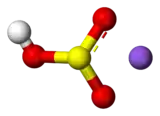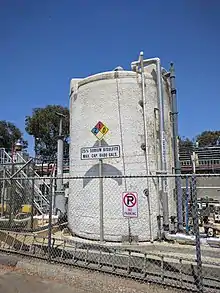Sodium bisulfite
Sodium bisulfite (or sodium bisulphite, sodium hydrogen sulfite) is a chemical mixture with the approximate chemical formula NaHSO3. Sodium bisulfite in fact is not a real compound,[2] but a mixture of salts that dissolve in water to give solutions composed of sodium and bisulfite ions. It is a white solid with an odour of sulfur dioxide. Regardless of its ill-defined nature, "sodium bisulfite" is a food additive with E number E222.
 | |
 | |
| Names | |
|---|---|
| IUPAC name
Sodium hydrogen sulfite | |
| Other names
E222, sodium bisulphite | |
| Identifiers | |
3D model (JSmol) |
|
| ChEBI | |
| ChEMBL | |
| ChemSpider | |
| ECHA InfoCard | 100.028.680 |
| E number | E222 (preservatives) |
PubChem CID |
|
| RTECS number |
|
| UNII | |
CompTox Dashboard (EPA) |
|
| |
| |
| Properties | |
| NaHSO3 | |
| Molar mass | 104.061 g/mol |
| Appearance | White solid |
| Odor | Slight sulfurous odor |
| Density | 1.48 g/cm3 |
| Melting point | 150 °C (302 °F; 423 K) |
| Boiling point | 315 °C (599 °F; 588 K) |
| 42 g/100 mL | |
Refractive index (nD) |
1.526 |
| Hazards | |
EU classification (DSD) (outdated) |
Harmful (Xn) |
| R-phrases (outdated) | R22 R31 |
| S-phrases (outdated) | (S2), S25, S46 |
| NFPA 704 (fire diamond) | |
| Flash point | Non-flammable |
| NIOSH (US health exposure limits): | |
PEL (Permissible) |
none[1] |
REL (Recommended) |
TWA 5 mg/m3[1] |
IDLH (Immediate danger) |
N.D.[1] |
| Related compounds | |
Other anions |
Sodium sulfite Sodium metabisulfite |
Other cations |
Potassium bisulfite |
Except where otherwise noted, data are given for materials in their standard state (at 25 °C [77 °F], 100 kPa). | |
| Infobox references | |
Synthesis
Sodium bisulfite solutions can be prepared by treating a solution of suitable base, such as sodium hydroxide or sodium bicarbonate with sulfur dioxide.
- SO2 + NaOH → NaHSO3
- SO2 + NaHCO3 → NaHSO3 + CO2
Attempts to crystallise the product yield sodium disulfite, Na2S2O5.[3]
Reactivity and uses

Sodium bisulfite is a common industrial reducing agent, as it readily reacts with dissolved oxygen:
- 2 NaHSO3 + O2 → 2 NaHSO4
It is usually added to large piping systems to prevent oxidative corrosion. In biochemical engineering applications, it is helpful to maintain anaerobic conditions within a reactor.
It is used for preserving food and beverages.
See also
- Sodium metabisulfite
- Calcium bisulfite
- Potassium bisulfite
- Croscarmellose sodium
- Sulfurous acid
References
- NIOSH Pocket Guide to Chemical Hazards. "#0561". National Institute for Occupational Safety and Health (NIOSH).
- Tudela, David; Jenkins, H. Donald B. (2003). "New Methods to Estimate Lattice Energies: Application to the Relative Stabilities of Bisulfite (HSO3−) and Metabisulfite (S2O52-) Salts". Journal of Chemical Education. 80 (12): 1482. Bibcode:2003JChEd..80.1482T. doi:10.1021/ed080p1482.
- Johnstone, H. F. (1946). "Sulfites and Pyrosulfites of the Alkali Metals". Inorganic Syntheses. Inorganic Syntheses. 2. pp. 162–167. doi:10.1002/9780470132333.ch49. ISBN 9780470132333.
